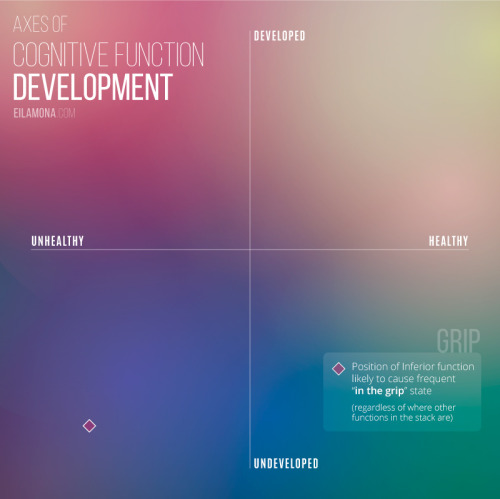eilamona: Cognitive Function DevelopmentI have been asked about function development many times, and
eilamona: Cognitive Function DevelopmentI have been asked about function development many times, and I can’t properly explain without distinguishing between developed and undeveloped, healthy and unhealthy.(Note: These graphs are made for the purpose of illustrating my point only. They are my own estimates, and not based on any research or collected data.)UndevelopedThe usage of the function is in its raw, basic form.The usage is usually one-dimensional and not adaptable (e.g. undeveloped inferior Ne only seeing negative possibilities).Untrusted and undervalued by the user, but is nonetheless present.The user often do not recognize an undeveloped function’s influence on their thought process, and thus they have no (or little) control over it.When it becomes prominent, usually under pressure, it is “explosive” and uncontrollable (e.g. inferior function grip).DevelopedThe function is multifaced. The user can utilize it in many intricate and complex ways.The function easily adapts to support many different situations in life.The user has mastered the function, trusts their own ability to use it in their thought process, and consciously consults it often.The user has a comradery with the function, and rely on it to make important decisions in their lives.UnhealthyThe function is used in negative, unproductive, and destructive ways (to self and others).An unhealthy function is often used in isolation without consulting other functions with the opposite extraversion/introversion preference (e.g. dominant-tertiary loop, where the auxiliary function is undeveloped), unless the functions around it is also unhealthy.For example, an INFJ girl with unhealthy Ni-Fe “knows” that her friend is dating a wrong person who is likely to cheat on them, plans and proceeds to sabotage their friend’s relationship through manipulation because she knows what is best for her friend, and doesn’t stop to ask what the friend actually wants (a true story).HealthyThe function is used in a beneficial, productive, and constructive ways (to self and others).A healthy function works together with other functions around it.For example, an INFJ girl with a healthy Ni-Fe picks up signs that her friend’s new romantic partner is very non-committal. She cares for her friend and what they want, and decides to talk to her friend about it. It turns out that her friend is aware of this, but explains that their partner will be leaving the country in a few months anyway, and that they’re ok with the non-commitment. She respects her friend’s autonomy, but will still support them whenever they have relationship problems.-eilamona[ MBTI Merch | Support eilamona on patreon ] -- source link
Tumblr Blog : eilamona.com
#mbti theory


